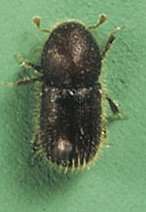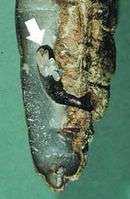Date stone beetle
| Date stone beetle | |
|---|---|
 | |
| Scientific classification | |
| Kingdom: | Animalia |
| Phylum: | Arthropoda |
| Class: | Insecta |
| Order: | Coleoptera |
| Family: | Curculionidae |
| Subfamily: | Scolytinae |
| Tribe: | Scolytini |
| Genus: | Coccotrypes |
| Species: | C. dactyliperda |
| Binomial name | |
| Coccotrypes dactyliperda Fabricius, 1801 | |
The date stone beetle or button beetle, Coccotrypes dactyliperda, is an insect belonging to the bark beetles (Scolytinae). It feeds on and spends part of its life cycle in dates, the fruits of the date palm (Phoenix dactylifera). Because of its damage to dates, it is considered a pest.
Adults of the species are reddish-brown and 1.8–2.3 mm (0.07–0.09 in) long, with a convex shape and hairs on the dorsal surface.[1] Characteristic of beetles, they have four wings, with the pair of hardened forewings protecting the pair of hindwings used for flying. They chew a round hole into green unripe dates, causing the fruit to drop 1 or 2 days later.[2]


The species uses the haplodiploid sex-determination system: females are diploid while males are haploid; unmated females produce male offspring by parthenogenesis while mated females produce both male and female offspring. Both in beetles from collected date stones and in laboratory cultures, about 85–93% of the adults are females.[2]
When a flying unfertilized female reaches a target such as a date stone, sweet almond, betel nut, nutmeg, cinnamon bark[3] or a button made from vegetable ivory, hence the name "button beetle"), she bores a hole in it and excavates a chamber. (Males cannot penetrate the stone.[2]) Inside, she produces a brood of four or five males. She mates with the first son that reaches maturity, then proceeds to eat them all. She then enlarges the chamber and lays a brood of about 70 offspring. Some of the females mate with their brothers.[4][5]
It takes about 22–25 days for an egg to develop through a larva and pupa into an adult, with males developing faster than females. Mated females live on average 73 days while unmated ones live on average 63 days.[2]
References
- ↑ "Palm seed borer", Pests and Diseases Image Library, retrieved 2009-03-13
- 1 2 3 4 D. Blumberg & M. Kehat (June 1982), "Biological studies of the date stone beetle, Coccotrypes dactyliperda", Phytoparasitica, 10 (2)
- ↑ Simmons, Perez, and Howard D. Nelson. 1975. Insects on Dried Fruits. U.S. Department of Agriculture, Agricultural Research Service, Agriculture Handbook 464.
- ↑ William D. Hamilton (August 15, 1993), "Inbreeding in Egypt and in this book: a childish perspective", in Nancy Wilmsen Thornhill, The natural history of inbreeding and outbreeding, University of Chicago Press, pp. 429–431, ISBN 0-226-79855-0
- ↑ P. Büchner (1961), "Endosymbiosestudien an Ipiden. I. Die Gattung Coccotrypes", Zeitschrift für Morphologie und Ökologie der Tiere (50): 1–80